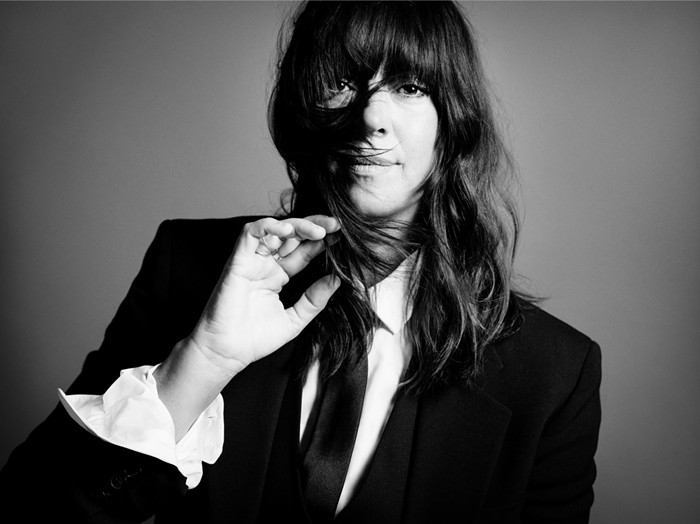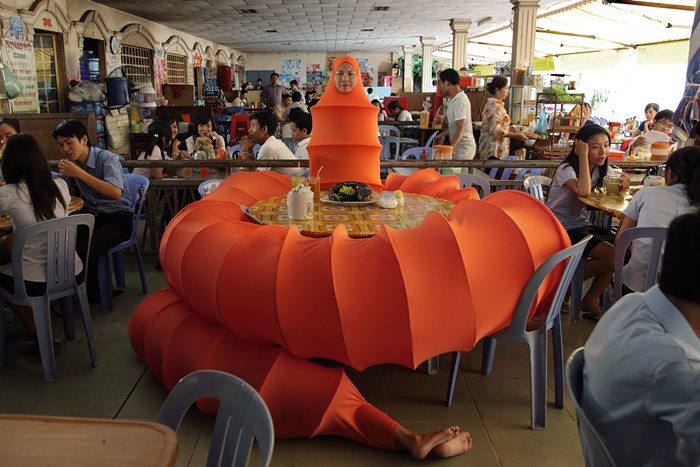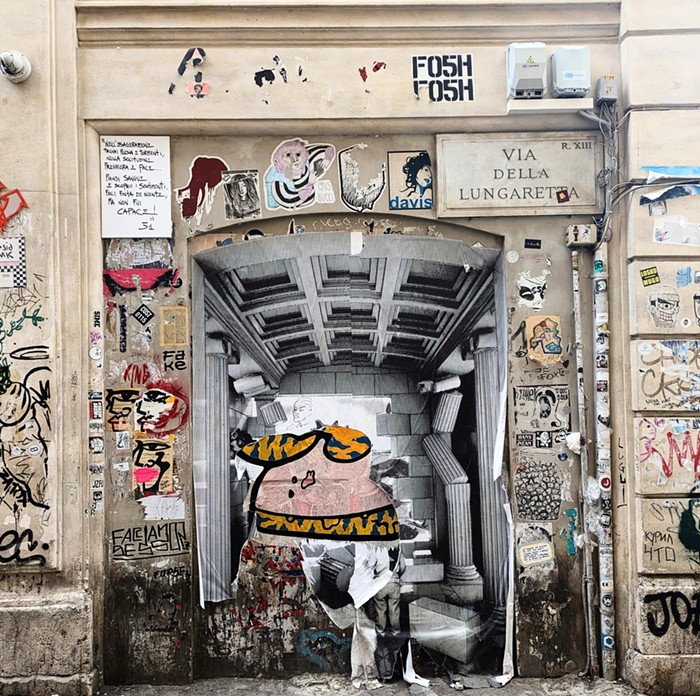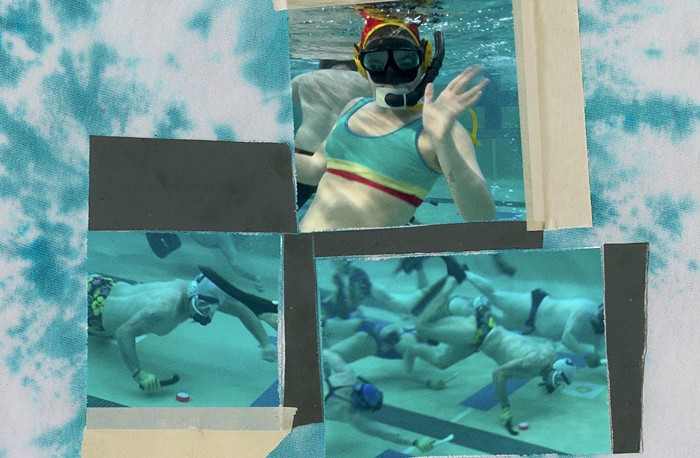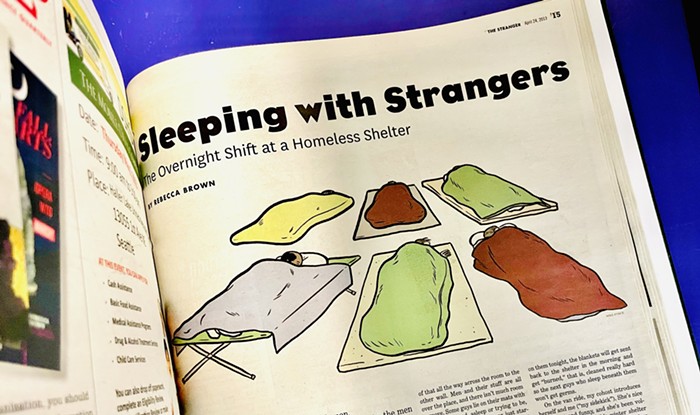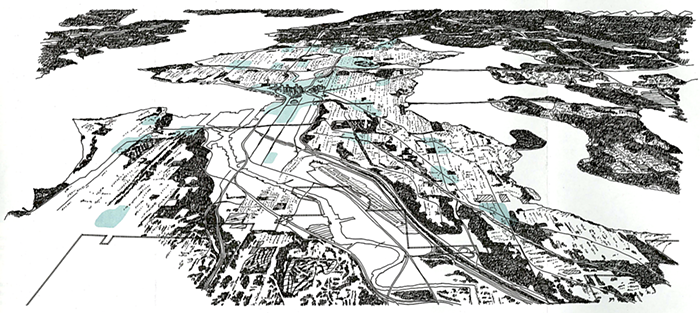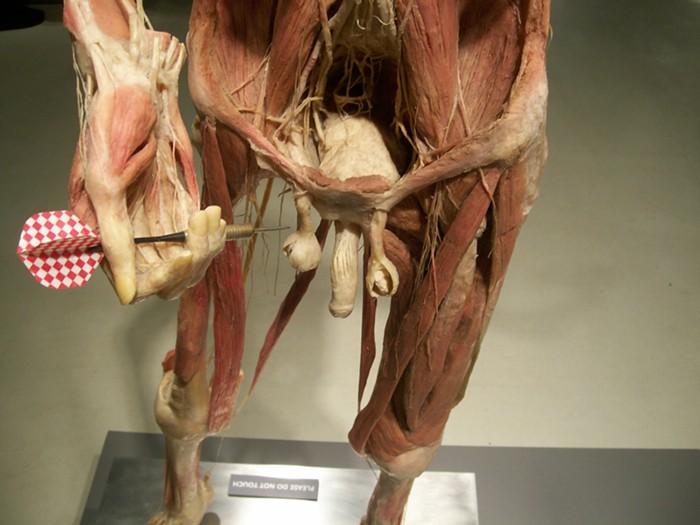Western Bridge is one of the most important places to see art in Seattle. Exhibitions thoughtfully mix and remix a permanent collection that's always increasing and advancing in connection to the world around it. Everything finds expression in a flexible and atmospheric showplace that's an architectural statement in itself. Nothing is for sale. It's like an ideal museum. But what we never think about is the delicate fact that all of it—this monument of civic good, where a recent opening brought together, liquored up, and fed big sloppy sandwiches to hundreds of people—rises from the tip of one tiny, fragile act: the first time Bill and Ruth True said, "I love you."
Western Bridge is the Trues' gallery, where they show what they've bought together, and where they invite everybody to explore why they've bought it and what it all means. Their new show, Parenthesis (as in parent-thesis), is a reminder of both the essential power and the incredible fragility of the family—the family as the edifice upon which all of society's edifices are built, but the family also as nothing more than the reverberations of a whispered promise.
It's hard holding both these ideas at once, accepting them, but trying to do so has a rich history in art. The heartsick Dadaists of the early 20th century, their spirits broken by the devastations of World War I, lashed out at the conventions of art, sure. But when I first read Tristan Tzara's 1918 Dada manifesto in college, as a kid still angry over my parents' messy divorce and the messy new relationships that followed, I was moved by Tzara's childlike claim that "every product of disgust that is capable of becoming a negation of the family is dada." If the family, like art, could not be a strong, safe nest, then it had to be abolished; it's less painful to do away with families than to watch them fail. (Dada was always from the perspective of a disillusioned child.)
"The family, just like money, is based on a leap of faith," artist Guy Ben-Ner tells his son in the video Stealing Beauty, one of the many highlights of Parenthesis. Ben-Ner, his wife, his son, and his daughter enact a day-in-the-life domestic scenario in IKEA store displays as people shop around them. Everything they touch has a price tag on it; they mime activities like dishwashing and toothbrushing, and the sounds are added in the editing. In the story line about the son stealing from the neighbor boy (and the parallel plotline that the father covets the neighbor's mother), and in staged discussions between the children and their parents, the video articulates the rifts between hard systems of economics and the soft social experiences they're founded on. We see the stereotypical bourgeois family unit. The father works and brings the money; the mother shops and spends the money. The daughter asks her father complicated questions, and the father responds in conflicting aphorisms: The children "are our investments for the future," but "Princess, some things in life are not for sale." The tone is not strictly ironic; Ben-Ner presents a family that's both mockable and familiar, built on clichés that are true because we reinforce them. Stealing Beauty is cerebral but also touching.
The staircase leading up to the room where Stealing Beauty plays is the opposite of cerebral. It acts directly on the body. It's a replica of the central staircase in Jennifer Zeyl's childhood home (there was a step she'd sit on when she was in trouble). She re-created it at 150-percent scale, so walking up it is especially taxing, while walking down it is slightly dangerous. On these stairs, you have a double awareness: You have the mind of an adult but the body of a child.
Zeyl is not a formal visual artist, she's a set designer (and a Stranger theater Genius), but her set pieces—she also re-created the front door from her childhood home as an entrance to the show—function masterfully both as experiential sculptures and as the choreography of the whole exhibition. Western Bridge's two-story space has never been altered this dramatically. It's transformed into a sort of meta-home with new arrangements of rooms and hallways and passageways. The theatrical framework underscores the idea that a family is something that has to be performed in order to survive. A home is a set that tells us what to do as much as it reflects us.
Of course the art is good; this is Western Bridge. And there are some works you'd expect: a Sally Mann photograph of her children at half-naked play; a Tina Barney photograph of an upscale family; Neil Goldberg's video of his father breathing onto a mirror, proving his existence. But most things are terrific surprises. In Kerry Tribe's two-channel video Here and Elsewhere, on loan and playing in the giant back room (the garage/toolshed in this model?), a father interviews his daughter about memory and representation. The questions and answers are based on footage from 1977 by Jean-Luc Godard and Anne-Marie Miéville, and the two channels aren't quite lined up, which leads to fractured sequences that pose the same questions visually as the father does verbally. The daughter tries to please her father, enacting how parents educate children through a mishmash of explicit explanation and implicit example.
Jessica Jackson Hutchins proposes parenting as an endurance sport in her 49-minute video of a road trip with her squirmy 2-year-old. Ann Hamilton presents it as an obsession; she runs her finger, with a camera attached to it, over a photograph of her child's face as she whispers about the lines and parts as if not to wake it. In portraying their children or parents, all the artists portray themselves, too. Goldberg's videos of his parents—they recite dreams he's had of them in one video; in the next, his father describes their system for writing thank-you cards after the mother's funeral (the phrase "Thank you for your visit during the shiva period" might be paired with the phrase "We hope you remember Shirley as she was in the picture attached," for instance)—are simple and accessible, but hint at the incredible folds and layers in every family complex, which are never all visible to any member.
Part of the upstairs floor of Western Bridge was originally designed as an apartment with a kitchen, a bedroom, and a bathroom. For Parenthesis, this space is dominated by portraits of True family members: Bill and Ruth's parents and their five children (one together, two from his former marriage, two from her former marriage), in photographs by Alice Wheeler and Colleen Chartier, among other artists. You don't see Bill and Ruth's faces here. They're everywhere and nowhere. ![]()

